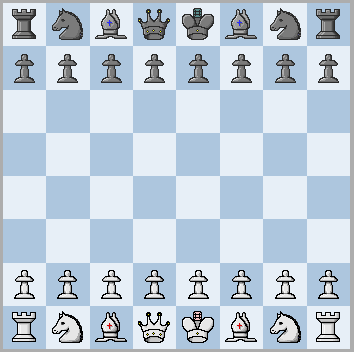

In Pushpawn Chess a connected pawn on the fourth or fifth rank can push back an enemy pawn that is placed before it, provided that the square behind the enemy pawn is empty. A Pawn that is situated adjacent to a friendly pawn, diagonally or horizontally, counts as “connected”. (In an alternative variant, only an enemy pawn on the fifth rank can be pushed.) It opens up many new tactical possibilities, especially in the endgame. Draws will occur less often. It is now more advantageous to have a blocked pawn on the fifth rank. Opening and middle game aren’t much affected; but endings become more critical thanks to the new push move. This is a promising amendment to the rules of chess.
The pawn chain emulates a medieval shield wall. As the pawn is blocked by a shield, it cannot capture directly forward. Instead, it captures diagonally forward, which was a typical method, also in the roman army. But there is a move missing, namely a push move. In the ancient and medieval battle situation, soldiers tried to push the enemy shield wall back, to create a breach. The new push move emulates this ancient tactics. (In order to do this, a soldier must be accompanied by at least one friendly soldier, because a lone soldier cannot form a shield wall.)
Endgame example
 In standard chess, this is a draw. In Pushpawn Chess, White can push back the center pawn and achieve a winning position. (Note that only “connected” pawns can do the push move.)
In standard chess, this is a draw. In Pushpawn Chess, White can push back the center pawn and achieve a winning position. (Note that only “connected” pawns can do the push move.)
Opening example
 After the opening moves 1.e4 e5 2.Nf3 d6 3.d4 Black may push back the white pawn at e4. It is allowed because the e5 pawn is connected with the pawn on d6. (Should Black instead play 3…Nd7, then White may push back the e5 pawn, because the e4 pawn is connected with the d4 pawn.)
After the opening moves 1.e4 e5 2.Nf3 d6 3.d4 Black may push back the white pawn at e4. It is allowed because the e5 pawn is connected with the pawn on d6. (Should Black instead play 3…Nd7, then White may push back the e5 pawn, because the e4 pawn is connected with the d4 pawn.)
 However, after the moves 3…e5-e4(p) 4.Nd2, the position is still advantageous for White. The white pawn cannot be pushed further back, because the black pawn on e4 isn’t connected. Note that White may not push back the black pawn on e4, because the white pawn is on the third rank. The push move is only allowed for connected pawns on the fourth and fifth rank. Should the pawn push move be allowed only for pawns on the fourth rank, or for pawns both on the fourth and fifth rank? Perhaps the latter alternative is too radical. Time will tell which variant is the best.
However, after the moves 3…e5-e4(p) 4.Nd2, the position is still advantageous for White. The white pawn cannot be pushed further back, because the black pawn on e4 isn’t connected. Note that White may not push back the black pawn on e4, because the white pawn is on the third rank. The push move is only allowed for connected pawns on the fourth and fifth rank. Should the pawn push move be allowed only for pawns on the fourth rank, or for pawns both on the fourth and fifth rank? Perhaps the latter alternative is too radical. Time will tell which variant is the best.
☛ You can download my free Pushpawn Chess program here (updated 2020-11-25), but you must own the software Zillions of Games to be able to run it (I recommend the download version).
☛ Don’t miss my other chess variants.
© M. Winther, 2020 November